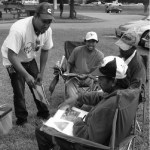At Reveal, Amy Julia Harris and Shoshana Walter investigate an increasing criminal justice trend in which defendants are sent to rehab, instead of prison. On its face, the idea is a good one, especially for people struggling with addiction. However, the reporters find that many so-called rehab centers are little more than labor camps funneling unpaid workers into private industry.
The story focused on one particular center, Christian Alcoholics & Addicts in Recovery (CAAIR) in Oklahoma. Started by chicken company executives, CAAIR’s court-ordered residents work full-time at Simmons Foods…
low-wage work
At the Toronto Star, reporter Sara Mojtehedzadeh went undercover as a temp worker at Fiera Foods, an industrial bakery, to investigate why temp workers are more likely to get hurt on the job. Earlier this year, Canadian occupational health and safety officials brought charges against the company, whose clients include Dunkin’ Donuts, Costco and Walmart, for the death of 23-year-old Amina Diaby, who was strangled to death after her hijab got caught in a machine.
Mojtehedzadeh, along with Brendan Kennedy, write:
I get about five minutes of training in a factory packed with industrial equipment…
The whole world is one global supply chain. Brand name companies like Nike, Apple, Hasbro, and dozens of apparel companies do not actually make the consumer products they sell. Instead they hire contract manufacturers in the developing world to produce their goods, and these contractors have sub-contractors, and sub-sub-contractors, all the way down to industrial homework in workers’ homes. Global supply chains start with processing the products’ raw materials, manufacturing parts and the finished product, and then transportation to the consumer.
How can a conscientious consumer or…
At the Huffington Post, Dave Jamieson reports that labor unions are stepping up to help protect increasingly vulnerable immigrant workers from deportation. In fact, Jamieson writes that in many instances, labor unions have become “de facto immigrants rights groups,” educating workers on their rights and teaching immigrants how to best handle encounters with immigration officials.
Jamieson’s story begins:
Yahaira Burgos was fearing the worst when her husband, Juan Vivares, reported to the Immigration and Customs Enforcement office in lower Manhattan in March. Vivares, who fled Colombia and…
Massive “clean-up” projects are underway in Houston and the surrounding region. As the waters brought by Hurricane Harvey recede, individuals seeking work---day laborers---will be assembling in damaged neighborhoods and offering their skills. It was a commonplace scene following Superstorm Sandy's destruction in 2012, and in Harvey’s disaster zone, day laborers are already on street corners and in parking lots offering to work.
I hope the workers’ experiences from Superstorm Sandy are lessons being reviewed by officials, leaders, and funders in Houston. It would be time well spent if they…
Drivers honked and waved. They gave thumbs up to the 30 people on the sidewalk. The group was holding signs outside a North Carolina poultry plant. “El baño” – the bathroom – was the word catching the drivers’ attention.
The scene on August 14 was a demonstration in front of the Case Farms poultry plant in Morganton, NC. The company supplies chicken to KFC, Popeyes, and Taco Bell.
Alisa Olvera outside of Case Farms poultry plant in Morganton, NC.
The reason for the peaceful protest?
The Case Farms plant has a sanitation problem. Workers don’t have access to the bathroom when they need to…
At The New York Times, Elizabeth Olson writes about the challenges that older workers face in proving workplace bias. She begins the story with Donetta Raymond, a longtime manufacturing worker laid off, along with hundreds of others, by Spirit AeroSystems Holdings. Now, some of those workers are bringing a lawsuit after discovering that nearly half of the laid-off workers were 40 or older, the age when federal age discrimination protections kick in. Olson writes:
Such lawsuits are popping up as the nation’s work force ages and as many longtime workers claim that they are being deliberately…
At PBS Newhour, Aubrey Aden-Buie reports on the shipbuilders that receive billions in federal contracts despite histories of serious safety lapses. In a review of federal contracts, Aden-Buie and colleagues found that since 2008, the federal government has awarded more than $100 billion to companies with records of safety incidents that injured and killed workers.
In a transcript of the broadcast (which you can also watch at the link above), Aden-Buie interviews Martin Osborn, a welder at shipbuilder Austal USA in Alabama:
MARTIN OSBORN: I was up in a boom lift, as we call it, or a man…
At the Intercept, Avi Asher-Schapiro reports on a new insurance plan that Uber is offering its drivers that could help them recoup wages and cover medical expenses if they’re injured on the job. Asher-Schapiro notes that while some have described the Uber insurance plan — which workers buy by setting aside 3.75 cents per mile — as a form of workers’ compensation, it hardly fits the bill. In fact, in documents obtained by the Intercept, Uber explicitly states that the insurance plan isn’t workers’ comp. He writes:
Compared to traditional workers’ compensation insurance, Uber’s policy…
At the Center for Public Integrity, a five-part investigative series on safety at the nation’s nuclear facilities finds that workers can and do suffer serious injuries, yet the Department of Energy typically imposes only minimal fines for safety incidents and companies get to keep a majority of their profits, which does little to improve working conditions. Reporters estimated that the number of safety incidents has tripled since 2013.
For example, in 2009, the chair of a safety committee at Idaho National Laboratory told high-ranking managers that damaged plutonium plates could put workers…
At the Guardian, Krithika Varagur interviewed workers inside the Indonesian factory that manufactures clothing for Ivanka Trump’s fashion line, finding poverty wages, anti-union intimidation and unreasonably high production targets. The story includes interviews with more than a dozen workers, who asked that details about their identities be changed to avoid being fired. Varagur writes:
Alia is nothing if not industrious. She has worked in factories on and off since leaving her provincial high school, through the birth of two children, leading up to her current job making clothes for brands…
My typical afternoon snack has its roots in New York’s $14 billion a year dairy industry. The state leads the country in Greek yogurt production. A new report by the Workers’ Center of Central New York (WCCNY) and the Worker Justice Center of New York (WJCNY) fills me in on the laborers who make possible my daily cup of Chobani. I understand better now why many, many dairy parlor workers say their employers care more about the cows than the well-being of their employees.
Milked: Immigrant Dairy Farmworkers in New York State is based on interviews with 88 dairy workers from 53 different farms…
At Eater, Elizabeth Grossman reports that Democratic lawmakers have introduced legislation that would protect undocumented agricultural workers from deportation and provide them and their families with a path to long-term residence and citizenship.
The bill proposes that farmworkers who can prove at least 100 days of agricultural work in the last two years could apply for a “blue card” that grants temporary residency and the ability to work. Farmworkers with a blue card and who work for 100 days a year for five years or 150 days a year for three years would then be eligible for a green card…
At BuzzFeed, Kate Moore tells the story of the “radium girls,” the hundreds of women during WWI who worked painting watch dials with luminous radium paint — a substance that would eventually poison and kill them even though they were told it was perfectly safe. What followed was years of employers covering up and denying evidence that radium was killing workers, while berating the women for attempting to get help with their mounting medical bills.
Eventually, Moore writes, their fight for justice led to one of the first cases in which an employer was held responsible for the health of workers…
The southern U.S.’s construction boom is not translating into better wages and working conditions for construction workers. Those are the results of a survey of 1,435 construction workers from six southern U.S. cities: Atlanta, Charlotte, Dallas, Houston, Miami, and Nashville. The survey, which was administered during July and August 2016, was a collaboration between the Texas-based Workers Defense Project, the Partnership for Working Families, and Nik Theodore, PhD with the University of Chicago's Department of Urban Planning and Policy. Their report, Build a Better…
At ProPublica, Michael Grabell investigates how U.S. companies take advantage of immigrant workers, focusing on Case Farms poultry plants, which former OSHA chief David Michaels once described as “an outrageously dangerous place to work.” He reports that Case Farms built its business by recruiting some of the world’s most vulnerable immigrants, who often end up working in the kind of dangerous and abusive conditions that few Americans would put up with.
Grabell chronicles the history of Case Farms and how it first began recruiting refugees from Guatemala who were fleeing a brutal civil war in…
Yesterday was a notable one in the efforts to improve working conditions for U.S. poultry processing workers. At a Perdue chicken processing plant in Salisbury, Maryland, faith leaders and worker advocates delivered some special packages to company officials. Thirteen hundred miles way in Springdale, Arkansas, the U.S. largest poultry company announced new initiatives to improve conditions for its poultry processing workforce. I tip my hat to the diverse coalition of worker advocates who set the stage for these event. More on their contribution below, but first the story from Salisbury,…
At Bloomberg BNA, Stephen Lee reports that with fears of deportation looming, undocumented immigrants are becoming afraid to access legal remedies when they’re injured on the job. The article notes that such immigrants are disproportionately employed in hazardous jobs and while they account for just 15 percent of the overall workforce, they account for 18 percent of occupational fatalities. Lee writes:
Sofia, a Mexican fieldworker in Santa Rosa, Calif., has a workers’ compensation case in the works after hurting her arm and shoulder pulling vine roots, requiring surgery. But she says she’s…
Worker revolt in Myanmar smashes garment factory and apparel brands’ false promises of a better life
In February 2017, garment workers enraged by abusive and illegal working conditions stormed their factory and smashed $75,000 worth of equipment after attacking factory managers. The worker revolt in the one of the poorest and most vulnerable countries in the world also revealed the broken promises of international clothing brands that sweatshop apparel production would lead to better lives and “empowerment” of the overwhelmingly female garment workforce in Myanmar.
The Hangzhou Hundred-Tex Garment factory is Chinese-owned and exclusively produces for Swedish apparel giant Hennes &…
At the Center for Public Integrity, Talia Buford and Maryam Jameel investigate federal contractors that receive billions in public funds despite committing wage violations against their workers. In analyzing Department of Labor data on more than 1,100 egregious violators, the reporters found that federal agencies modified or granted contracts totaling $18 billion to 68 contractors with proven wage violations. The Department of Defense contracted with the most wage violators.
Under Obama, labor officials had attempted to address the problem with the Fair Pay and Safe Workplaces rule, which…


